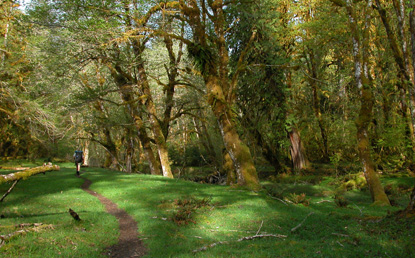In Greek mythology, Mount Olympus was a place from which gods ruled. Homer wrote in The Odyssey, “Neither is it shaken by winds nor ever wet with rain, nor does snow fall upon it, but the air is outspread clear and cloudless, and over it hovers a radiant whiteness.”
In Washington state, Mount Olympus is the highest peak on the Olympic Peninsula and none of this is true — winds pummel and rains soak and the mountain has been carved and cracked by the third largest glacial system in the Lower 48.
And, even though it’s the highest point on the peninsula, it’s not particularly high: 7,980 feet.
Still: Stand atop it, or even near it. Look over jagged peaks and lonely basins, over river valleys and alpine meadows; watch fog stream past; see first light set the highest points of rock afire; watch the sunset dowse them once again in darkness.
It is not difficult to imagine Olympus as a throne for gods.
Fittingly, then, the top is hard earned and not for everyone.
Yet, that’s what makes a trip to Mount Olympus so fantastic; somewhere on the long trail into its glaciers, there’s something for everyone.
The trail starts at the Hoh Rain Forest Visitor Center, elevation 573 feet. From there, it’s 17.5 miles to Glacier Meadows, where climbers camp. But you don’t have to be a climber to camp there, and you don’t have to haul in all 17.5 miles to camp. There are plenty of other spots to tent.
The first 13 miles of the trail are flat and easy, rambling along the river through temperate rain forest and some huge old growth cedars.
The national park service invites people to camp on gravel bars near the river, which is simple and low impact, or at established campsites (listed in order of hiking distance, from shortest to longest) at Tom Creek, Five Mile Island (about five miles from trail head), Happy Four, Olympus Guard Station (nine miles), Lewis Meadow (11 miles), Elk Lake (about 15 miles from trail head) and Glacier Meadows.
Permits are required for all camping, and can be obtained in person or reserved over the phone (they still have to be picked up in person). Reservations are required for groups of more than six people.
Between the trailhead and Lewis Meadow, the trail only gains 400 vertical feet. Between there and Elk Lake, it gains 1,600 feet, crossing the Hoh River on a footbridge above a dramatic gorge.
Along the way, it bears witness to one of the grandest forests left in the country, a place of more greens than rightly exists. Moss creeps and clings, and ferns spear from the ground.
From Elk Lake, the trail continues climbing steeply to Glacier Meadows, elevation 4,300 feet.
Past the meadows, the trail continues three quarters of a mile, climbing another 700 feet to the lateral moraine above Blue Glacier.
Unless you’re climbing, that’s the end of the road. If you’re climbing, you’ve only just finished the approach.
Either way, the view from the moraine is a spectacular panorama. The glacier snakes away, its source to the left, its terminus to the right. It is a fractured, crumpled, compressed artwork of ice and time and pressure. It’s not simply the radiant whiteness of Homer’s Olympus, but the dirty rock fall of moraine, the glowing azure of ice fissures, the deep blue-going-black of bottomless holes filled with achingly clear water.
Sunday, October 21, 2012
Tuesday, July 17, 2012
WASHINGTON STATE AND THE HOH RAINFOREST
Washington State is an aquatic wonderland of coastal waters, tide pools, saltwater inlets, glacier-fed rivers, low country and alpine lakes, reservoirs, protected wetlands and estuaries teeming with fish, birds and all sorts of watchable wildlife. It is also home to thousands of waterfalls, including some as dramatic and spectacular as Palouse Falls and Snoqualmie Falls. Located about 35 miles east of Seattle, Snoqualmie Falls had a big pop culture moment when it was featured in the opening sequence of the hit ‘90s TV showTwin Peaks.
Washington State offers almost unlimited opportunities for boating, kayaking, canoeing, whitewater river rafting, swimming, fishing, hiking, sightseeing, bird watching, duck hunting or just pondering as you watch the sun set over water.
What makes Washington “the Evergreen State”? Millions of acres of national parks, wilderness areas, forests, recreation and scenic areas, state forests and parks, reserves and preserves. Washington’s forests are diverse ecosystems densely populated with cedar, hemlock, Douglas fir, pine, spruce and other evergreens, with just enough deciduous trees to make fall spectacular.
Old-growth forests still stand tall in places like Olympic National Park, where you can look out from the Hurricane Ridge Visitor Center and see a rare and beautiful panorama of old-growth–covered mountains and river valleys. And in places like the Hoh Rainforest, an environment so beautiful and otherworldly you have to see it to believe it—and even then, you won’t believe it.
Washington State offers almost unlimited opportunities for boating, kayaking, canoeing, whitewater river rafting, swimming, fishing, hiking, sightseeing, bird watching, duck hunting or just pondering as you watch the sun set over water.
What makes Washington “the Evergreen State”? Millions of acres of national parks, wilderness areas, forests, recreation and scenic areas, state forests and parks, reserves and preserves. Washington’s forests are diverse ecosystems densely populated with cedar, hemlock, Douglas fir, pine, spruce and other evergreens, with just enough deciduous trees to make fall spectacular.
Old-growth forests still stand tall in places like Olympic National Park, where you can look out from the Hurricane Ridge Visitor Center and see a rare and beautiful panorama of old-growth–covered mountains and river valleys. And in places like the Hoh Rainforest, an environment so beautiful and otherworldly you have to see it to believe it—and even then, you won’t believe it.
Subscribe to:
Comments (Atom)
